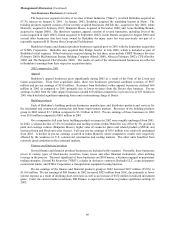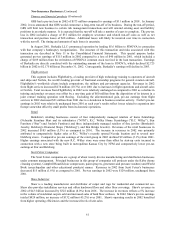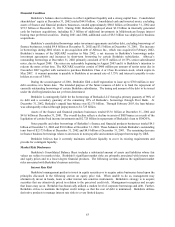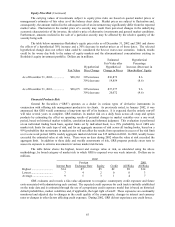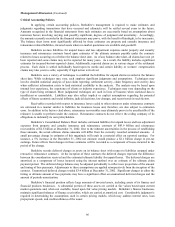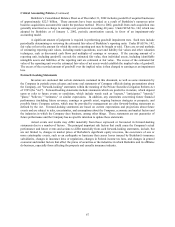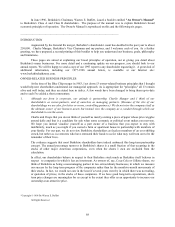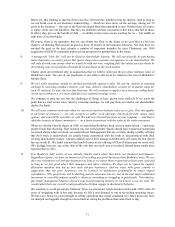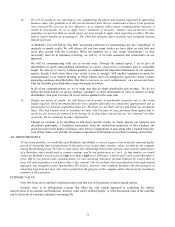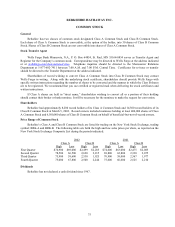Berkshire Hathaway 2002 Annual Report Download - page 67
Download and view the complete annual report
Please find page 67 of the 2002 Berkshire Hathaway annual report below. You can navigate through the pages in the report by either clicking on the pages listed below, or by using the keyword search tool below to find specific information within the annual report.66
Management's Discussion (Continued)
Critical Accounting Policies
In applying certain accounting policies, Berkshire’ s management is required to make estimates and
judgments regarding transactions that have occurred and ultimately will be settled several years in the future.
Amounts recognized in the financial statements from such estimates are necessarily based on assumptions about
numerous factors involving varying, and possibly significant, degrees of judgment and uncertainty. Accordingly,
the amounts currently recorded in the financial statements may prove, with the benefit of hindsight, to be inaccurate.
The balance sheet items most significantly affected by these estimates are property and casualty insurance and
reinsurance related liabilities, invested assets where no market quotations are available and goodwill.
Berkshire accrues liabilities for unpaid losses and loss adjustment expenses under property and casualty
insurance and reinsurance contracts based upon estimates of the ultimate amounts payable under the contracts
related to losses occurring on or before the balance sheet date. As of any balance sheet date, all claims have not yet
been reported and some claims may not be reported for many years. As a result, the liability includes significant
estimates for incurred-but-not-reported claims. Additionally, reported claims are in various stages of the settlement
process. Each claim is settled individually based upon its merits and certain liability or workers’ compensation
claims may take years to settle, especially if legal action is involved.
Berkshire uses a variety of techniques to establish the liabilities for unpaid claims recorded at the balance
sheet date. While techniques may vary, each employs significant judgments and assumptions. Techniques may
involve detailed statistical analysis of past claim reporting, settlement activity, claim frequency and severity data
when sufficient information exists to lend statistical credibility to the analysis. The analysis may be based upon
internal loss experience, the experience of clients or industry experience. Techniques may vary depending on the
type of claim being estimated. More judgmental techniques are used in lines of business when statistical data is
insufficient or unavailable. Liabilities may also reflect implicit or explicit assumptions regarding the potential
effects of future economic and social inflation, judicial decisions, law changes, and recent trends in such factors.
Receivables recorded with respect to insurance losses ceded to other reinsurers under reinsurance contracts
are estimated in a manner similar to liabilities for insurance losses and, therefore, are also subject to estimation
error. In addition to the factors cited above, reinsurance recoverables may ultimately prove to be uncollectible if the
reinsurer is unable to perform under the contract. Reinsurance contracts do not relieve the ceding company of its
obligations to indemnify its own policyholders.
Berkshire’ s Consolidated Balance Sheet includes estimated liabilities for unpaid losses and loss adjustment
expenses from property and casualty insurance and reinsurance contracts of $43.9 billion and reinsurance
recoverables of $2.6 billion at December 31, 2002. Due to the inherent uncertainties in the process of establishing
these amounts, the actual ultimate claims amounts will differ from the currently recorded estimated amounts. A
small percentage change in estimates of this magnitude will result in a material effect on reported earnings. For
instance, a 5% increase in the December 31, 2002 net estimate would produce a $2.1 billion charge to pre-tax
earnings. Future effects from changes in these estimates will be recorded as a component of losses incurred in the
period of the change.
Berkshire records deferred charges as assets on its balance sheet with respect to liabilities assumed under
retroactive reinsurance contracts. At the inception of these contracts the deferred charges represent the difference
between the consideration received and the estimated ultimate liability for unpaid losses. The deferred charges are
amortized as a component of losses incurred using the interest method over an estimate of the ultimate claim
payment period. The deferred charge balance may be adjusted periodically to reflect new projections of the amount
and timing of loss payments. Adjustments to these assumptions are applied retrospectively from the inception of the
contract. Unamortized deferred charges totaled $3.4 billion at December 31, 2002. Significant changes in either the
timing or ultimate amount of loss payments may have a significant effect on unamortized deferred charges and the
amount of periodic amortization.
Berkshire’ s financial position reflects large amounts of invested assets, including assets of its finance and
financial products businesses. A substantial portion of these assets are carried at fair values based upon current
market quotations and, when not available, based upon fair value pricing models. Berkshire’ s finance businesses
maintain significant balances of finance receivables, which are carried at amortized cost. Considerable judgment is
required in determining the assumptions used in certain pricing models, which may address interest rates, loan
prepayment speeds, and creditworthiness of the issuer.






